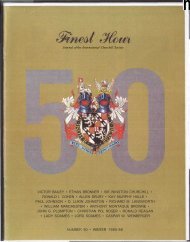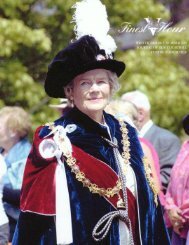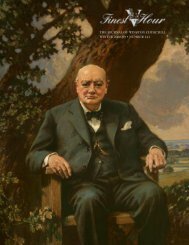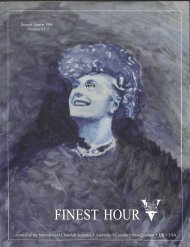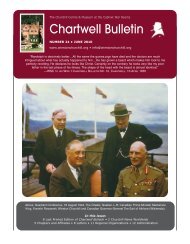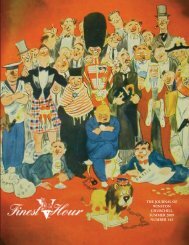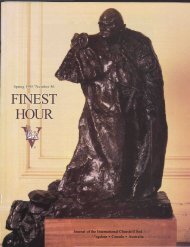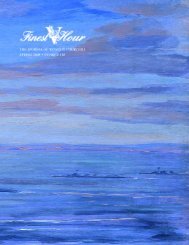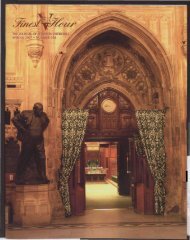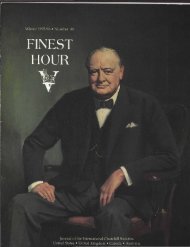You also want an ePaper? Increase the reach of your titles
YUMPU automatically turns print PDFs into web optimized ePapers that Google loves.
WARTIME JOURNEYS...<br />
again in 1939-40, he had visited or traveled aboard a variety<br />
of naval vessels. He substantially expanded this experience<br />
over the five years of his wartime premiership.<br />
Flamingoes, Flying Boats and Commando<br />
<strong>Churchill</strong>’s wartime travels began less than a week<br />
after he became Prime Minister. His first five treks were to<br />
France during the May-June six-week war, usually in one of<br />
three new de Havilland D.H. 95 Flamingo transports of<br />
RAF No. 24 (Commonwealth) Squadron, based at RAF<br />
Hendon. The twin-engine Flamingo was all-metal—though<br />
de Havilland had built only wooden aircraft up to that<br />
point. It held twelve to seventeen passengers. The Flamingos<br />
were registered G-AFUE, G-AFUF, and R2765, though none<br />
was given an individual name, a then-common practice. 6<br />
Always escorted by fighters (since German aircraft<br />
posed a growing threat), <strong>Churchill</strong> flew to Paris three times;<br />
then pursued the retreating French leadership on difficult<br />
and dangerous flights to Briare, eighty miles south of Paris,<br />
and later to Tours on the eve of French capitulation. The<br />
flights were uneventful—and, sadly, so were the talks.<br />
Eighteen months later, returning from meetings with<br />
Allied leaders in Washington and Ottawa in January 1942,<br />
<strong>Churchill</strong> made his first flight across the Atlantic aboard<br />
Berwick, a Boeing 314A flying boat 7 painted in olive drab<br />
camouflage with large Union Flags under her cockpit<br />
windows. She was flown by British Overseas Airways<br />
Corporation (BOAC) personnel under military orders.<br />
The plane was comfortably fitted with peacetime<br />
luxury furnishings and food service for VIPs. Her cabin was<br />
divided into several compartments, including a dining area<br />
and separate bathrooms for men and women. Passengers<br />
could move about, and comfortable full-length bunks could<br />
be folded down from the bulkhead. Until the arrival of his<br />
Skymaster transport toward the end of the war, the flying<br />
boat was <strong>Churchill</strong>’s most luxurious airplane.<br />
Headed for Bermuda and a sea voyage home, WSC<br />
climbed into the Boeing’s cockpit and happily sat opposite<br />
the pilot with a cigar clamped in his teeth. He was so taken<br />
with the plane that he inquired of Captain John Kelly<br />
Rogers whether Berwick could fly him home. Assured that<br />
she could, <strong>Churchill</strong> cancelled plans to sail back from<br />
Bermuda. Rogers took on a full load of fuel and saved the<br />
Prime Minister several days in transit.<br />
Six months later, <strong>Churchill</strong> made his only Atlantic<br />
round trip by air during the war. Only a handful of prewar<br />
passenger flights had followed that route, though military<br />
aircraft were being regularly ferried across by mid-1942. On<br />
17 June 1942, <strong>Churchill</strong> and his party boarded BOAC’s<br />
Bristol (a sister to Berwick) at Stanraer, Scotland, flying to<br />
Baltimore. Ten days later, they returned on a northerly route<br />
via Newfoundland.<br />
Above: In a de Havilland D.H. 95 Flamingo, <strong>Churchill</strong> had several<br />
anxious moments shuttling to France in Spring 1940, but the<br />
German fighters they observed did not see them. Below: WSC<br />
waves from the bridge of Commando; note symbols of its travels.<br />
A trip to the Middle East and on to Moscow in<br />
August 1942 (see article following) involved the first airplane<br />
assigned specifically to WSC: an American-built<br />
Consolidated LB-30A named Commando. Based on the<br />
four-engine B-24 bomber but with a single tail like U.S.<br />
Navy variants, she was one of a growing number of<br />
bombers and transports flying the risky Atlantic (nearly fifty<br />
air personnel were killed in the ferrying process over five<br />
years). Commando was piloted by William J. Vanderkloot,<br />
who had flown airliners before the war. With his navigation<br />
and piloting experience, he was appointed as <strong>Churchill</strong>’s<br />
pilot by Air Chief Marshal Charles Portal. He and the plane<br />
had arrived from Montreal, conveying three Canadians to<br />
Prestwick, near Glasgow. 8<br />
Despite being assigned to the PM, Commando was a<br />
far cry from the flying boats. Her deep fuselage lacked<br />
windows (the cargo plane on which she was based didn’t<br />
need them); the only outside light came from the cockpit.<br />
There were drafts, and at first no heat; the shelves in the<br />
back of the cabin were the only sleeping accommodation,<br />
though a simple cooking stove was provided. Lacking cabin<br />
pressurization, Commando rarely flew over 8000 feet,<br />
enough to surmount most bad weather. Her name painted<br />
at a jaunty angle under the cockpit, the lumbering giant was<br />
painted matte black, for she often flew at night. 9<br />
FINEST HOUR 148 / 12



